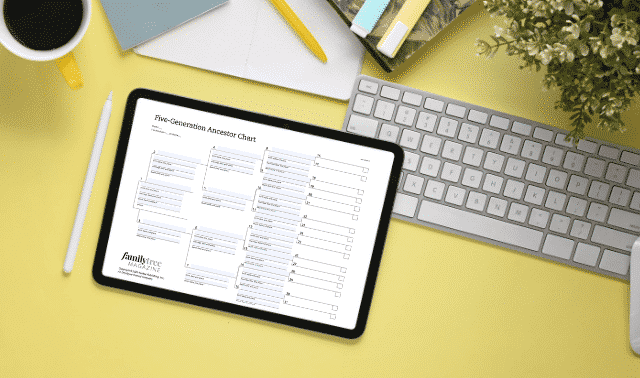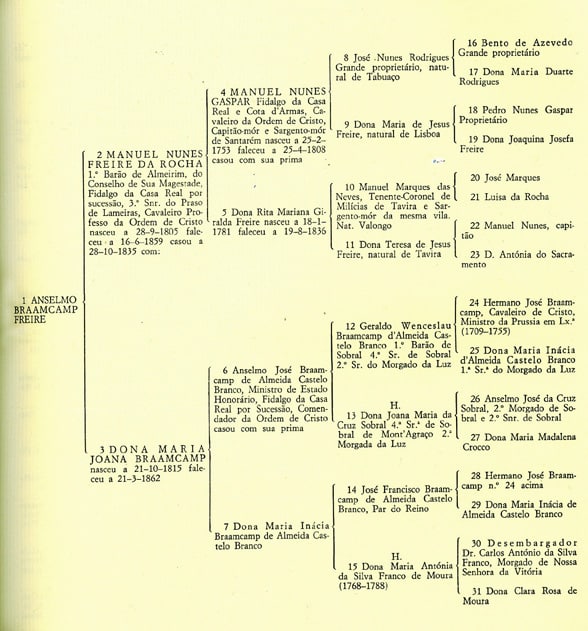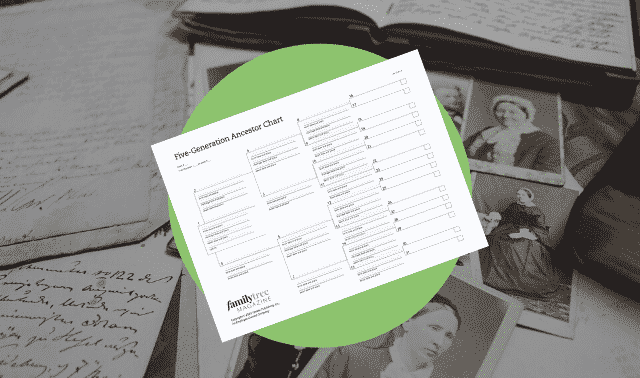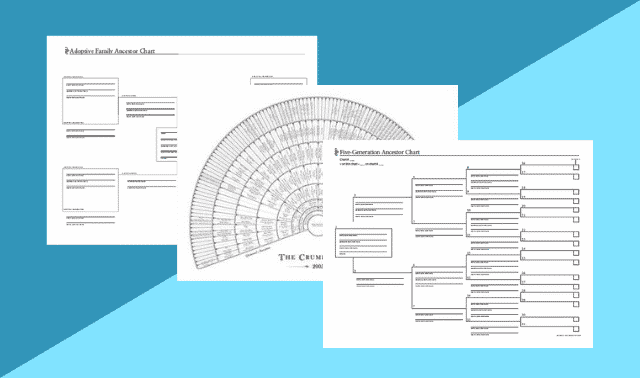Sign up for the Family Tree Newsletter! Plus, you’ll receive our 10 Essential Genealogy Research Forms PDF as a special thank you.
Get Your Free Genealogy Forms
"*" indicates required fields

It sounds like an easy enough starting point: Fill out a family tree chart. But once you get started, this seemingly simple task becomes bewildering. Where do your siblings, aunts and uncles go? How do you deal with Grandma’s second marriage? Do you use her maiden or married name? And what do all those numbers mean?
Not to worry. After you’ve learned the format of standard genealogy charts and worksheets, you’ll see why generations of genealogists have found them so handy—they let you pack all your essential family facts onto a few sheets for instant reference. If you want to know how to draw a family tree, these tips can also help ensure your tree is accurate and thorough.
No matter what kind of family tree you’re creating, there are a few basic principles to keep in mind. In Family History 101 (Family Tree Books), beginning genealogy instructor Marcia D. Yannizze Melnyk provides five guidelines.
1. Write surnames in capital letters.
The all-caps approach lets you (or someone reading your charts) immediately distinguish last names from first and middle names. At first, this might seem unnecessary—but when you run into kin named Guillaume GAUTIER de LACHENAYE, Sebastiano Giovanni DI CARLO and the like, you can see the importance.
2. If you know middle names, spell them out.
Naturally, this helps you distinguish Grandpa William Randolph Reynolds from Grandpa William Robert Reynolds. Remember, too, that some people went by their middle names. For example, my great-great-grandpa Charles George Michael Hauck was known to all as Michael, and that’s how he shows up in most US records.
3. Always record nicknames, denoting them in quotation marks.
Again, you want to show your ancestors’ full identities, so you can match up family history to the right relative. This is especially useful for kin whose nicknames don’t relate at all to their real names, such as my uncle Everett “Butch” Smith.
4. List women’s maiden names, not their married names.
Since you’re recording your female ancestors right next to their husbands, including their married names is redundant. If you don’t know a woman’s maiden name, note that with a question mark or simply skip the surname.
5. Format dates as day, month, full year.
For consistency, genealogists write dates European-style, flip-flopping the American convention of month, day, year. To avoid any potential confusion, they also use the month’s abbreviation (Melnyk suggests putting it in capital letters) instead of a numeral. You know what 12 AUG 1836 means, whereas 12/8/1836 isn’t so clear; is that Aug. 12 or Dec. 8? If you haven’t yet established an exact date, you can use qualifiers such as by 1836, before 1911 or after 20 MAY 1893.
How to Chart Remarriages
What if your relative remarried after a divorce or a spouse’s death? Use the box labeled Other Spouses to note any additional marriages of the husband and/or wife. But don’t list offspring of those unions on the same sheet—instead, create separate family group sheets for those other marriages, and assign each child to the appropriate parents. So if your great-grandmother Naomi Crookshank had six children, four by her first husband, Silas Dobbins, and two by your great-grandfather Norbert Philpot, you’d make two family group sheets with Naomi as the mother: her four kids with Silas would go on one form, and the two with Norbert would go on the other.
You’ve probably noticed two Source # columns on your family group sheet. For each fact you record, you’ll want to note where you got that information on the back of the form or on a separate page. Just compile a running list of the sources, number each item, then write those numbers next to the corresponding details. You’ll probably list multiple sources for some facts, and use a single source for several different items.
Documenting facts may seem like a formality, but we guarantee you’ll be glad you did. When you refer back to certain details later or compare notes with a fellow researcher, you won’t find yourself wondering, “Where did I find Norbert’s burial location? And did Naomi’s birth date come from her marriage license or baptismal certificate?” (Although pedigree charts don’t have a designated place for documentation, you still can cite your sources. Either list them on the back of the chart, or note references to the sources on the corresponding family group sheets.)
Now that you know these best practices, it’s time to pick your charting method.
Common Family Tree Charts and Templates
Genealogists use an assortment of research forms. In fact, you can download dozens of different forms free from our website. But with so many options—from correspondence logs to calendars to census extraction forms—it’s easy to get overwhelmed. How do you know which ones you need?
All sorts of family forms can prove helpful, but beginning family history buffs will want to focus on the two staple worksheets every genealogist uses most: the pedigree chart and the family group sheet. The Ahnentafel Numbering System mentioned below is not a chart, but rather a system to helps you keep track of each person’s place in a family tree.
Pedigree Chart/Ancestor Chart
We’ll start with the pedigree chart, which is also called an ancestor chart. It comes in a variety of sizes, from giant 15-generation posters to the single-page five-generation worksheet. At first glance, you might think this chart looks like a basketball bracket—and it actually follows the same principle, only in reverse: Instead of beginning with many pairings and recording the outcome of each match until you’ve whittled the field to one, you’re starting with the end result (you) and working backward to fill in the “pairs” that preceded you.

Before you put pencil to paper, let’s go over a few basics. First, pedigree charts show only your ancestors: parents, grandparents, great-grandparents and so on (no aunts, uncles or cousins). Every column on the chart represents a generation. Below each person’s name is space for birth, marriage and death information—on some charts, you’ll see this abbreviated as b, m and d. In addition to dates, you’ll note places, with town, county and state (for instance, Petersburg, Boone, Ky.)
Pencils ready? Write your own information in the space marked 1. Then it’s time to move on to your parents—and our next rule: Men always go on the top space, and women below. So your dad will go on line 2, your mom on line 3, your dad’s father on line 4, his mother on line 5 and so forth.
Family Group Sheet
Now you’ve got ancestor charts down—but you don’t want to leave the rest of your relatives hanging. Enter the family group sheet. You’ll use this form to outline basic facts about one nuclear family: husband, wife and kids. Family group sheets let you account for all the siblings, aunts, uncles and cousins (so-called “collateral relatives”) who don’t make it onto your pedigree charts because they’re not your ancestors.
The format is pretty straightforward. In the top line identifying the family, pencil in the husband’s full name (not just his surname). That way, you can tell immediately whether you’re looking at the Wilbert Philpot family or the Norbert Philpot family, for example.
Directly below, fill in the husband’s and wife’s names; their birth, marriage and death details; and their parents’ names. At the bottom of the page (under Children of This Marriage), list the kids in birth order, following each name with birth, marriage and death information. Voilà! You now have a snapshot of three generations on a single sheet.
How to Use the Ahnentafel Numbering System
Ahnentafel Numbering is one of the genealogical numbering systems typically used in family books, journals and the reports in your genealogy software. These schemes actually are designed to help you organize family facts according to a common standard.
All those numbers help you keep track of each person’s place in your family tree, just as rankings on a basketball bracket tell you any given team’s position in the original field.
The Ahnentafel numbers used on pedigree charts are the simplest numbering system. To delineate descendancy—one person’s offsprings—most genealogists use the NGSQ System (short for National Genealogical Society Quarterly; also called the Modified Register System) and the Register System (named for the New England Historical and Genealogical Register). (The book Numbering Your Genealogy is a great resource for learning about these two systems.)
Here’s how they work: You start with the forefather, who is number 1. Below him, his kids get listed in birth order with Roman numerals (i, ii, iii). Both systems give children sequential Arabic numbers (2, 3, 4) to identify the kids when they appear later — but the systems assign these numerals differently. In the Register System, only children who have their own offspring get Arabic numerals. NGSQ gives everyone Arabic numerals, then denotes people whose lines continue forward with plus signs (+).
Simply double any ancestor’s Ahnentafel number to determine his father’s number; add one to dad’s number, and you’ll have mom’s. That means even numbers always represent men; odd numbers, women.
And what of those superscript numbers? They indicate the generation. To help you keep the line of descent straight, the systems parenthetically list each person’s ancestors, along with their generation numbers. So a Register-format entry might look like:
9. Friedrich³ Von Snortmacher (Helmut², Kermit¹).
26. i. Helga4 Von Snortmacher
ii. Karl Von Snortmacher
27. iii. Wilhelm Von Snortmacher
This tells you Friedrich is Kermit’s grandson and Helmut’s son. You also know two of Friedrich’s kids, Helga and Wilhelm, had children—whose names you’d find under 26 and 27, Helga’s and Wilhelm’s individual entries. See here for detailed explanations and examples of these systems.
Ahnentafel numbers can prove really useful when you extend your family tree past a single page. Suppose you’ve traced your mother’s paternal line beyond your great-great-grandfather (number 26), and you’d like to make a new chart that begins with him. Instead of numbering from scratch, you can pick up where you left off: Put great-great-grandfather in the first space, but change the 1 to 26. In his father’s space, change the number from 2 to 52, convert his mother’s 3 to 53, and continue for each generation: Space 6 becomes 106; 12 becomes 212 and so on.
If you don’t renumber subsequent charts, you can use the “1 on this chart = _ on chart _” line at the top of each page to keep people straight. In our example for your great-great-grandfather, you’d write “1 on this chart = 26 on chart 1.”
A version of this article appeared in the May 2006 issue of Family Tree Magazine.








